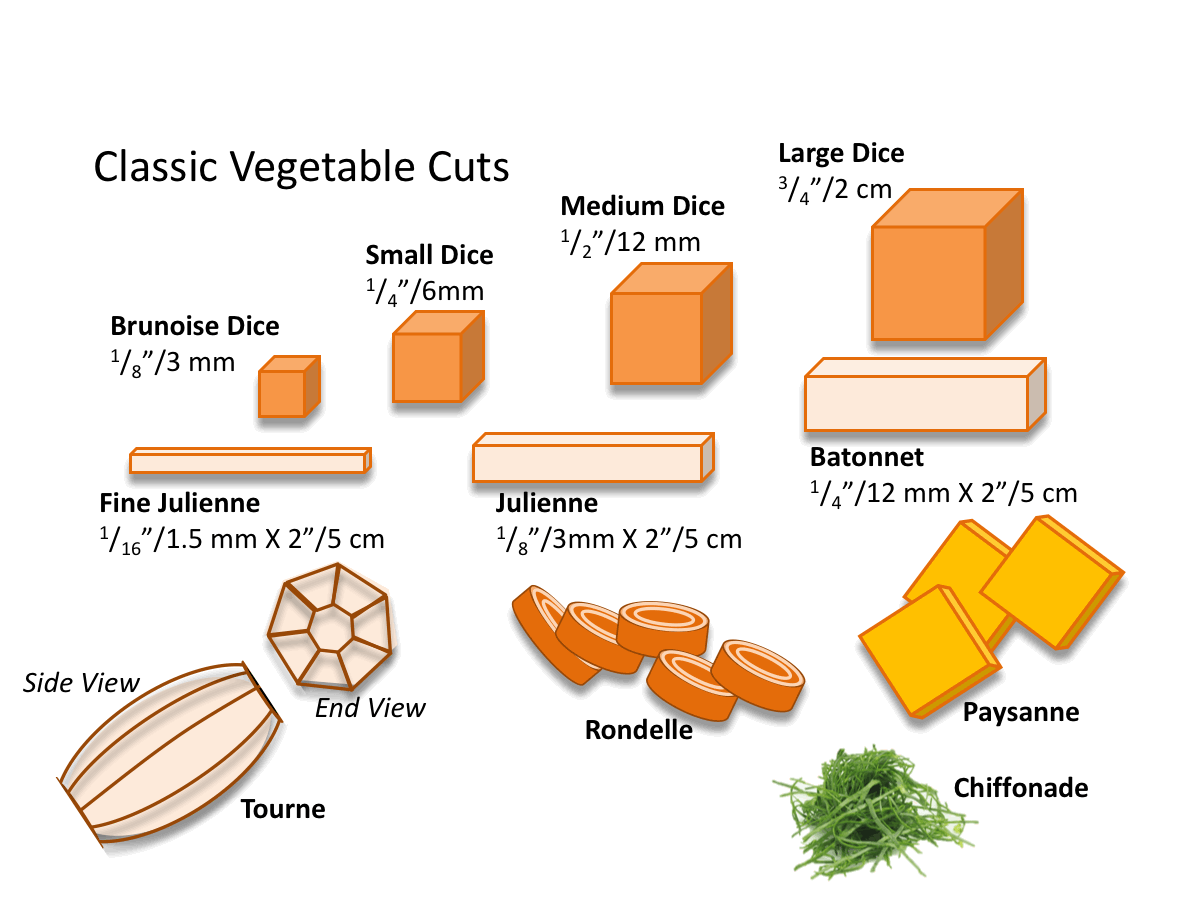Culinary Ratios
While every professional kitchen uses recipes for specific preparations, most food production follows routine techniques and procedures that cooks learn through practice and repetition. Culinary ratios are one tool that helps cooks be more efficient and productive in the kitchen without the need for recipes. Ratios aid in recipe analysis and formulation and open up a chef’s creativity to modify and create new recipes while helping achieve a better understanding of the science of cooking.
Ratios Defined
Whereas conventional recipes use specific ingredient measurements, culinary ratios are a fixed proportion of ingredients to one another. Instead of measuring by cups or pounds, ingredients are defined in “parts” relative to each other in quantity. By using ratios, production can be easily scaled to the desired amount. Ratios can also be used to develop recipes, which can be evaluated through ratio analysis to test for accuracy.
Types of Ratios
Ratios are calculated by weight and volume or through mixed methods incorporating a combination of weight, volume, or count. Examples of ratios by weight include a roux (equal parts fat and flour) or a bread dough (flour and water); by volume, they include a simple syrup (equal parts water and sugar) or a rice pilaf (2 parts liquid to 1 part rice), or by count when preparing a hollandaise sauce (6 egg yolks for every 1 lb. of butter). As a way of speeding and simplifying the cooking process, these and other simple ratios are helpful and, compared to a recipe, relatively easy to memorize.
“Examples of ratios by weight include a roux (equal parts fat and flour) or a bread dough (flour and water), by volume they include a simple syrup (equal parts water and sugar) or a rice pilaf (2 parts liquid to 1 part rice), or by count when preparing a hollandaise sauce (6 egg yolks for every 1 lb. of butter). ”
Ratios can be devised for almost any preparation, even complex ones. For example, a basic ratio for a braise uses 10 parts protein, 1 part mirepoix, and 1–2 parts liquid as its foundation. This simple ratio can be applied to any braise or stew, whether you are preparing a pot roast, a fricassee, or an Indian curry. The mirepoix may morph into an Italian soffrito or incorporate mushrooms, garlic, and shallots. The liquid might include wine, beer, or stock; the fat may be olive oil, butter, or bacon. However, the process—and the ratio—even with all these variables, holds true. There are ratios for soups and sauces, risotto, grains, legumes, and bread and pastries. Once you start thinking about ratios, the possibilities are endless.
Ratio Guidelines and Challenges
Ratios are basic science formulas of ingredients and do not include information on procedures or techniques. They also don’t take into account individual preferences of taste, texture, consistency, or the addition of other ingredients. Knowledge of fundamental culinary techniques, good organization skills, accurate measuring, and the ability to balance flavors and seasonings are essential to their success.
Ratios based on weight are the most accurate method for a professional kitchen, but they also require the ability to convert between different measurements. For example, a ratio for preparing a stock calls for 3 parts liquid to 2 parts bones (3 lbs. water to every 2 lbs. of bones), which means converting the water to a liquid measure (knowing that a one-pint liquid measure equals one pound takes out the mystery).
Ratios include only the major components of food preparation and don't include additional ingredients, flavorings, or seasonings that may alter their mix or cause yields to fluctuate (large-scale cooking often requires seasoning or leavening adjustment). For example, In a standard 3:1 ratio for vinaigrette, oils differ in flavor and viscosity, while vinegar differs in color, flavor, and intensity, so changing from white wine vinegar to balsamic vinegar or from neutral-tasting vegetable oil to full-flavored olive oil will alter the taste and the ratio. This is where the science of cooking becomes art and requires the chef's judgment to adjust the ratio according to the desired outcome.
How to Use The Ratios
We use ratios as a quick culinary reference. Unless otherwise noted, ratios here and throughout the website are based on weight. To understand a ratio, recall that each “part” is in relation to the next “part” (for example, the ratio for a white stock is 3 parts water to 2 parts bones). In the case of a stock, start by thinking of a part as specific weight, such as 1 part equaling 1 pound, so for every 2 pounds of bones, three pounds (or three pints) of water is needed. If a gallon of stock is desired, multiplying the ratio quantity by three will require 9 pounds or 9 pints of water (which equals 4 ½ quarts or a little over one gallon) and 6 pounds of bones. For each gallon of stock desired, mirepoix (onions, celery, carrots) is added at 1 lb./450 g per gallon. Remember that ratios are general guidelines that will not always add up to even quantities.
Other Kitchen Measurement Methods
In addition to traditional recipes and ratios, scaling recipes by percentages is used in culinary and pastry production. Percentages differ from ratios; understanding the differences will help avoid calculating errors. Percentages are based on 100 percent for all ingredients combined in a preparation. A mirepoix can be expressed as a ratio of 2 parts onion to 1 part carrots and 1 part celery, or it can also be described as 50% onions, 25% carrots, and 25%. Percentages are helpful in recipe development and analysis, similar to ratios.
Baker's Percentage/Baker’s Math
A baker’s percentage, also known as baker’s math, differs from a simple percentage and is used in large-scale production applications. In recipe formulas, all ingredients are expressed as a percentage in relation to the weight of flour, which is always described as 100 percent. If flour is not an ingredient in the preparation, substitute the ingredient of the highest proportion, for example, cream in a custard. All ingredients, including eggs and liquid, are scaled not by volume or count but by weight. The chart on the right illustrates an example of a recipe formula for a cake using Baker's math.
Since each ingredient is weighed based on its mass, bakers can work precisely using a single unit of measure that can be easily scaled up or down. It also makes it possible to quickly assess a formula simply by analyzing the percentages of ingredients.
Comparison of Ratio, Baker’s Percentage/Baker’s Math, and Simple Percentage
Since culinary professionals may encounter various measuring theories, it’s helpful to understand the differences in these methods of scaling ingredients. Ratios are common in culinary practice, whereas baker’s percentage, or baker’s math, as the name implies, is found mainly in the baking and pastry discipline. Simple percentages can be found in either culinary or baking, plus they are also used extensively in determining food, labor, and operating costs. A comparison of the three methods is illustrated in the following table:




